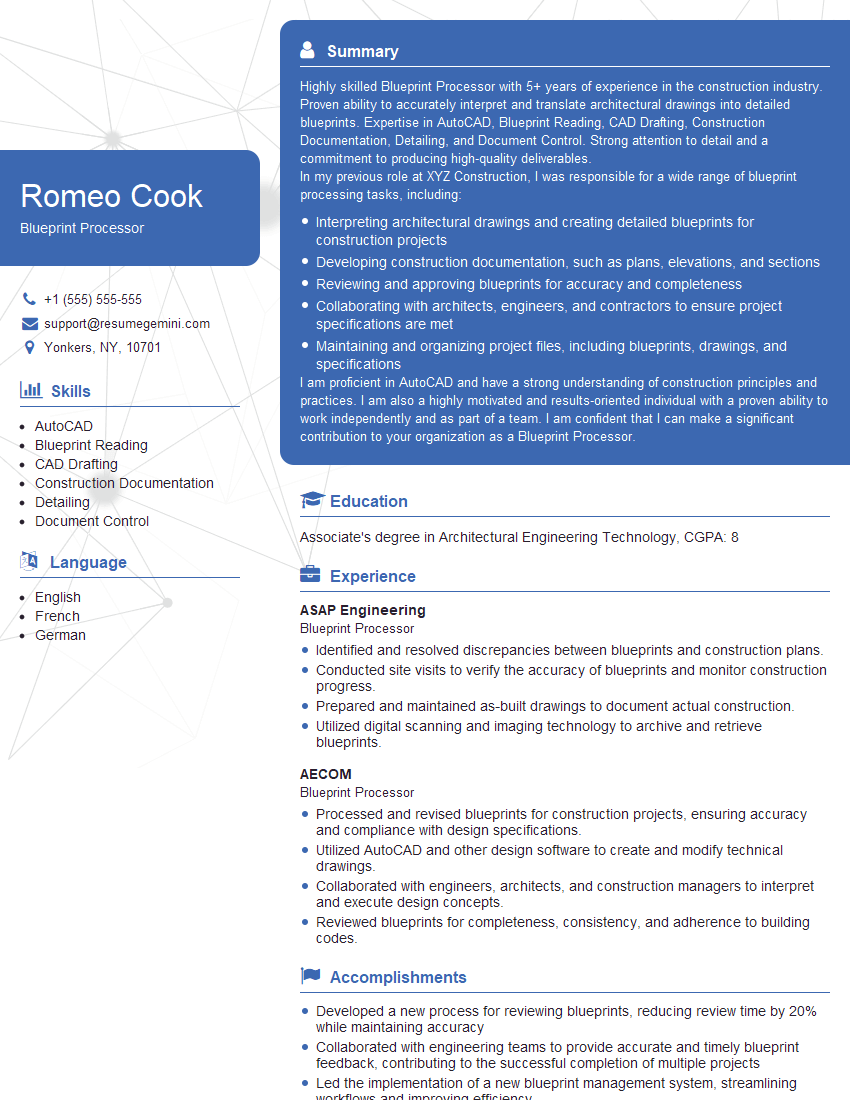Are you a seasoned Blueprint Processor seeking a new career path? Discover our professionally built Blueprint Processor Resume Template. This time-saving tool provides a solid foundation for your job search. Simply click “Edit Resume” to customize it with your unique experiences and achievements. Customize fonts and colors to match your personal style and increase your chances of landing your dream job. Explore more Resume Templates for additional options.

Romeo Cook
Blueprint Processor
Summary
Highly skilled Blueprint Processor with 5+ years of experience in the construction industry. Proven ability to accurately interpret and translate architectural drawings into detailed blueprints. Expertise in AutoCAD, Blueprint Reading, CAD Drafting, Construction Documentation, Detailing, and Document Control. Strong attention to detail and a commitment to producing high-quality deliverables.
In my previous role at XYZ Construction, I was responsible for a wide range of blueprint processing tasks, including:
- Interpreting architectural drawings and creating detailed blueprints for construction projects
- Developing construction documentation, such as plans, elevations, and sections
- Reviewing and approving blueprints for accuracy and completeness
- Collaborating with architects, engineers, and contractors to ensure project specifications are met
- Maintaining and organizing project files, including blueprints, drawings, and specifications
I am proficient in AutoCAD and have a strong understanding of construction principles and practices. I am also a highly motivated and results-oriented individual with a proven ability to work independently and as part of a team. I am confident that I can make a significant contribution to your organization as a Blueprint Processor.
Education
Associate’s degree in Architectural Engineering Technology
October 2015
Skills
- AutoCAD
- Blueprint Reading
- CAD Drafting
- Construction Documentation
- Detailing
- Document Control
Work Experience
Blueprint Processor
- Identified and resolved discrepancies between blueprints and construction plans.
- Conducted site visits to verify the accuracy of blueprints and monitor construction progress.
- Prepared and maintained as-built drawings to document actual construction.
- Utilized digital scanning and imaging technology to archive and retrieve blueprints.
Blueprint Processor
- Processed and revised blueprints for construction projects, ensuring accuracy and compliance with design specifications.
- Utilized AutoCAD and other design software to create and modify technical drawings.
- Collaborated with engineers, architects, and construction managers to interpret and execute design concepts.
- Reviewed blueprints for completeness, consistency, and adherence to building codes.
Accomplishments
- Developed a new process for reviewing blueprints, reducing review time by 20% while maintaining accuracy
- Collaborated with engineering teams to provide accurate and timely blueprint feedback, contributing to the successful completion of multiple projects
- Led the implementation of a new blueprint management system, streamlining workflows and improving efficiency
- Trained junior Blueprint Processors, developing their technical skills and contributing to the teams ongoing success
- Provided proactive feedback to clients, ensuring clarity and addressing potential issues early in the blueprint design process
Awards
- Blueprint Processing Excellence Award for consistently meeting and exceeding industry quality standards
- Recognized for exceptional attention to detail and accuracy in blueprint processing
- Recipient of the Blueprint Process Innovation Award for developing a patentpending solution to streamline blueprint annotation
- Recognized for outstanding contributions to the Blueprint Processor Certification Program
Certificates
- AutoCAD Certified Professional (ACP)
- Blueprint Reading Certification
- CADD Technician Certification
- Certified Document Control Specialist (CDCS)
Career Expert Tips:
- Select the ideal resume template to showcase your professional experience effectively.
- Master the art of resume writing to highlight your unique qualifications and achievements.
- Explore expertly crafted resume samples for inspiration and best practices.
- Build your best resume for free this new year with ResumeGemini. Enjoy exclusive discounts on ATS optimized resume templates.
How To Write Resume For Blueprint Processor
- Highlight your experience in AutoCAD and other relevant software.
- Showcase your understanding of construction principles and practices.
- Demonstrate your ability to work independently and as part of a team.
- Quantify your accomplishments whenever possible.
- Proofread your resume carefully for any errors.
Essential Experience Highlights for a Strong Blueprint Processor Resume
- Interpret architectural drawings and create detailed blueprints for construction projects
- Develop construction documentation, such as plans, elevations, and sections
- Review and approve blueprints for accuracy and completeness
- Collaborate with architects, engineers, and contractors to ensure project specifications are met
- Maintain and organize project files, including blueprints, drawings, and specifications
- Manage the blueprint processing workflow and ensure deadlines are met
- Stay up-to-date on industry best practices and new technologies
Frequently Asked Questions (FAQ’s) For Blueprint Processor
What are the key skills required to be a Blueprint Processor?
The key skills required to be a Blueprint Processor include AutoCAD, Blueprint Reading, CAD Drafting, Construction Documentation, Detailing, and Document Control.
What is the educational background required to become a Blueprint Processor?
The educational background required to become a Blueprint Processor typically includes an Associate’s degree in Architectural Engineering Technology or a related field.
What are the typical job responsibilities of a Blueprint Processor?
The typical job responsibilities of a Blueprint Processor include interpreting architectural drawings, creating detailed blueprints, developing construction documentation, reviewing and approving blueprints, and collaborating with architects, engineers, and contractors.
What are the career prospects for Blueprint Processors?
The career prospects for Blueprint Processors are good, as the demand for skilled professionals in the construction industry is expected to grow in the coming years.
What is the average salary for a Blueprint Processor?
The average salary for a Blueprint Processor in the United States is around $50,000 per year.
What are the different types of companies that hire Blueprint Processors?
Blueprint Processors are employed by a variety of companies, including architectural firms, engineering firms, construction companies, and government agencies.